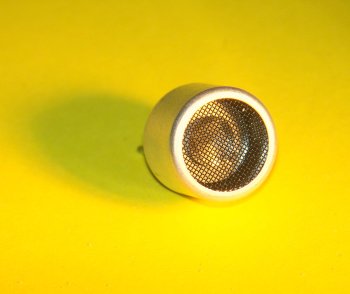Acoustic Data Transmission
June 14, 2021
The once
wired world has become
wireless. My
office desk and
floor in the early days of
computing were cluttered with a multitude of
cables that connected my
desktop computer to
printers,
data storage devices and our building's
local area networking. Some of those cables were thick, since they contained the many wires needed for the popular and somewhat speedy
parallel data port common on computers of that era. Some of the
equipment in my
laboratory was
interconnected by the even thicker cables of the
IEEE-488 General Purpose Interface Bus (GPIB).

A monster from the past. Looking very much like the multi-toothed mouth of some movie monster, this is a Centronics 36-pin female connector. The Centronics parallel port was used first to connect printers to computers in the 1970s. Parallel data connection was later simplified and implemented using a DB-25 connector for high-speed connection to other computer peripherals, such as Zip Drives. (Wikimedia Commons image.)
Today's connection to the
Internet is often wireless, enabled by our
smartphones. Early home connection to the Internet was made using
POTS, the
plain old telephone service. The earliest means for this was through an
acoustic coupler, a crude device that coupled a
telephone handset to a
loudspeaker and
microphone to allow a
tone representation of data to be sent and received. Since POTS had limited
frequency response, the
data rate was first limited to
110 baud. Later acoustic couplers had rates up to 1200 baud. In one implementation that I used to record data on
cassette tape, a 1200
Hz tone represented a "1," and a 2200 Hz tone represented a "0."
Acoustic couplers were needed, since the
Bell System would not allow direct connection to the
telephone network wiring. The
floodgates of telephone connection were opened by the
1968 Carterfone legal decision that allowed direct connection to the telephone wires if the device did not compromise the
safety and
integrity of the telephone network. Bell's position had been that they couldn't allow connection of devices other than their own, since these foreign devices could generate
voltages that would endanger their
equipment and
linemen. At that point,
modems became a common computer device, and the Internet was associated with their
signal tones.
Acoustic signaling existed long before the Internet, and one example we have in our
technological era is
underwater signaling that even included an
underwater telephone.
Historically, in
western civilization, we have
church bells and
alpine horns. These are mostly
alarm sounders, but
drums were used for long distance communication of actual messages in
Africa. The
West Africa talking drum is an
hourglass-shaped drum that's designed to allow for changes in
pitch that
imitates speech. Messages are transmitted through the use of low and high tones along with phrasing and pauses. This type of messaging will soon become extinct, since
cellphone adoption in Africa has been rapid.[1]

Ashanti drums, along with a drummer and an attentive audience.
The skulls are those of defeated tribal kings, and they are used to adorn the larger drum at the rear.
(Portion of an image from the United Kingdom National Archive, document record CO1069, via Wikimedia Commons.)
In a world in which everyone is trying to
steal each other's
secrets, it's no wonder that methods were developed to
eavesdrop on
information leaking from computers, printers,
fax machines, and other devices by means of unintended
electromagnetic emission and
emitted sound. A
countermeasure for this was
TEMPEST (Telecommunications Electronics Materials Protected from Emanating Spurious Transmissions).
Acoustic cryptanalysis attempts to gain information through unintended acoustical signals that can be obtained from a
hacked cellphone or a secretly placed microphone. These derive information from such devices as
computer keyboards,
impact printers, and
inkjet printers. In a more unconventional method,
electronic components such as
inductance coils and
capacitors will emit a faint sound when excited by normal operating
currents. In the early days of electronics, some
vacuum tubes would produce signals when acoustically excited through movement of their internal
electrodes. A converse operation, using
ultrasonic signals to take control of a
voice-assisted device, is also possible.[2]
Acoustic signaling can be used for good as well as evil. While current
television remote controls use
infrared for signaling, early versions used ultrasonic waves. The first of these employed
mechanically actuated metal tines to generate ultrasonic waves at different
frequencies for channel-up, channel-down, sound-on/off, and power-on/off. Later versions sent
digitally-coded signals from a
transducer operating at 40
kHz. This concept was used for remote control of devices other than televisions, often with just a relabeling of the
buttons on a television remote.

A 40 kHz ultrasonic transducer.
Similar transducers were used in early television remote controls. They were also used as the rangefinder for the autofocus feature in the Polaroid Sonar OneStep camera, introduced in 1978.
(Wikimedia Commons image by the author.)
Acoustic data transmission is not a fashionable topic, but James Nesfield
published a summary article of its uses at
Electronic Design two years ago.[3] One advantage that he cited is that many devices already contain the necessary loudspeaker and microphone for this data transmission mode, so a little
software can add value to existing
hardware.[3] One particular advantage which would be useful in
classroom and
conference settings is its
pairing-free,
one-to-many connectivity that has an advantage over
Bluetooth and
Wi-Fi, since no connection setup is required.[3]
Nesfield lists the following advantages of acoustic data transfer:[3]
• It Works Offline: The peer-to-peer nature of acoustic data transmission means that Internet connectivity is not required. It will work when no network access is available, which might be an important factor in developing countries.
• It Utilizes Existing Hardware.
• Secure, Private Data Transfer: No internet connection means less of a chance that your data will be stolen. Additionally, acoustic data transmission can still use cryptography.
• It Supports Many Platforms: Acoustic data transmission can work in devices ranging from smartphones, tablet computers, toys, and legacy systems.
• Scalable: Analog data transfer is scalable, and it can be used in simple Internet of things (IoT) devices.
• It Works in Extreme Environments: Proper signal-processing software allows the use of acoustic data transfer in most extreme environments.
References:
- Laura Silver and Courtney Johnson, "Internet Connectivity Seen as Having Positive Impact on Life in Sub-Saharan Africa," Pew Research, October 9, 2018.
- Sophie Bushwick, "Ultrasonic Attack Device Hacks Phones through Solid Objects," Scientific American, March 18, 2020.
- James Nesfield, "Sending Data Over Sound: How and Why?," Electronic Design, June 24, 2019.
Linked Keywords: Wire; wired; wireless network; office; desk; floor; computing; cable; desktop computer; computer printer; data storage device; local area network; parallel data port; laboratory equipment; laboratory; interconnectivity; interconnected; IEEE-488 General Purpose Interface Bus (GPIB); monster; multi-toothed; mouth; movie monster; Centronics 36-pin; vagina dentata; female connector; D-subminiature; DB-25 connector; computer peripheral; Zip Drive; Wikimedia Commons; Internet; smartphone; plain old telephone service; POTS; acoustic coupler; telephone handset; loudspeaker; microphone; pitch (music); tone; frequency response; bit rate; data rate; Bell 101 modem; 110 baud; >cassette tape; hertz; Hz; Bell System; landline; telephone network; floodgate; 1968 Carterfone legal decision; safety; structural integrity and failure; voltage; electronics; equipment; lineworker; lineman; modem; signaling (telecommunications); signal tone; acoustic; technology; technological; era; underwater acoustic communication; underwater signaling; underwater telephone; history; historical; western culture; western civilization; church bell; alphorn; alpine horn; alarm signal; alarm sounder; drums for long distance communication; Africa; West Africa talking drum; hourglass; hourglass-shape; imitation; imitate; speech; mobile phone; cellphone; Ashanti people; drum; audience; human skull; endemic warfare; defeated; tribal chief; tribal king; adorn; The National Archives (United Kingdom); United Kingdom National Archive; theft; steal; secrecy; secret; eavesdropping; eavesdrop; information; fax machine; electromagnetic field; electromagnetic emission; emitted sound; countermeasure; TEMPEST (Telecommunications Electronics Materials Protected from Emanating Spurious Transmissions); acoustic cryptanalysis; hacker (computer security); hacked; computer keyboard; impact printer; inkjet printer; electronic component; inductance coil; capacitor; electric current; vacuum tube; electrode; ultrasound; ultrasonic; virtual assistant; voice-assisted; television remote control; infrared; mechanics; mechanically actuated; metal; tine (structural); frequency; frequencies; digital; digitally-coded; transducer; kHz; push-button; rangefinder; autofocus; Polaroid SX-70; Polaroid Sonar OneStep; publishing; published; Electronic Design; software; hardware; classroom; academic conference; handshaking; pairing; one-to-many connectivity; Bluetooth; Wi-Fi; developing country; cryptography; tablet computer; toy; legacy system; scalability; scalable; Internet of things (IoT) device; signal-processing; extreme environment.